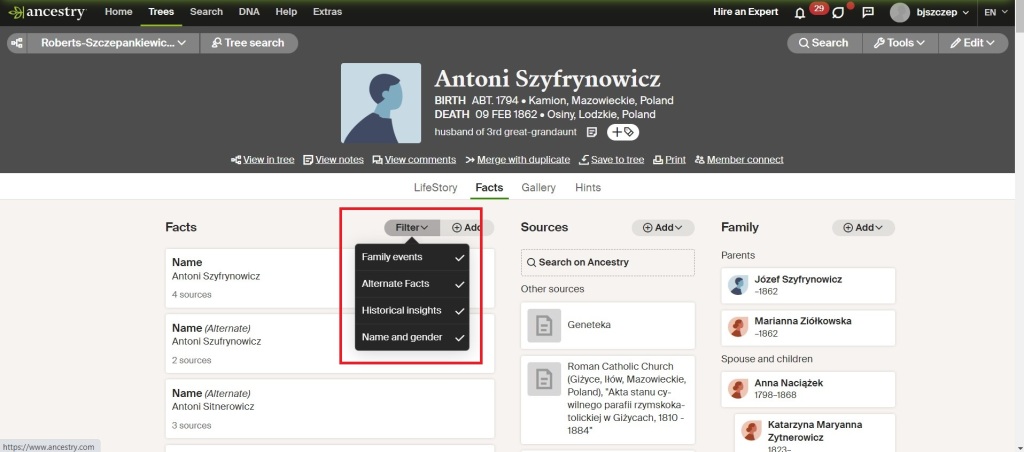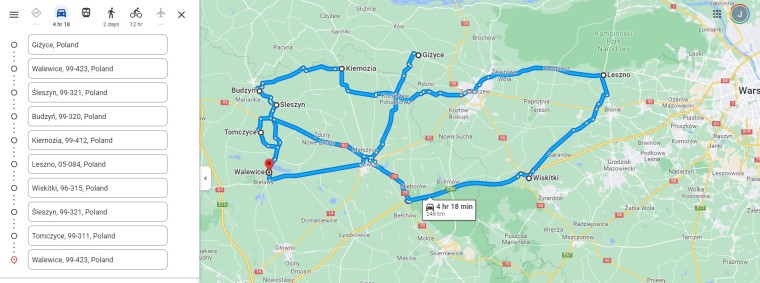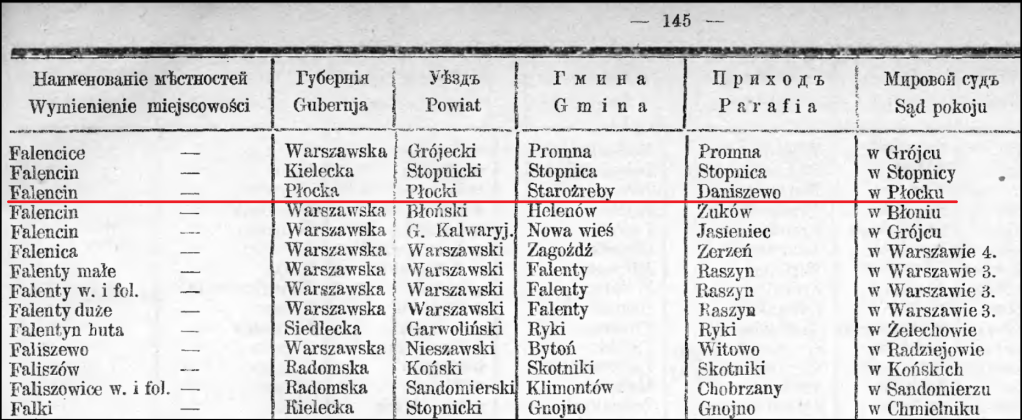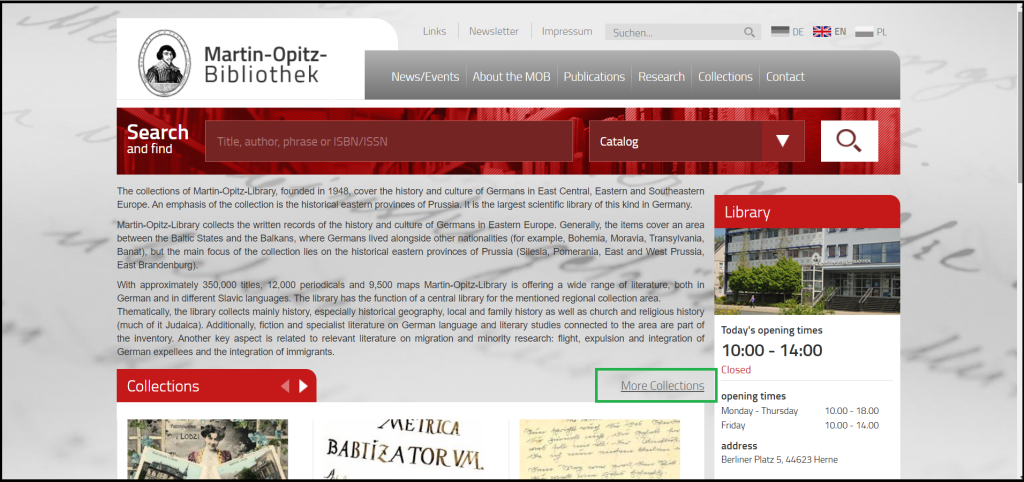In my last post, I discussed the challenges inherent to researching a family whose documented surname variants strayed from the usual etymological and phonetic path. As previously noted, Antoni Szyfrynowicz was an individual whose name was recorded with a number of variant spellings, and who was documented in historical records spanning an area of more than 4,000 square kilometers. Is it possible, then, that there was more than one Antoni Szyfrynowicz? Since genealogical research is all about resolving questions of kinship and identity, how do I know that all of the records I’ve found are for the same Antoni?
Antoni and Anna (Naciążęk) Szyfrynowicz: Digging Deeper with “Alternate Facts”
By and large, I think the evidence pretty consistently describes the same individual, although there are a few conflicts within the data set that need to be resolved. Let’s take a closer look at what we know about Antoni Szyfrynowicz, and discuss a bit of methodology along the way.
My favorite method for keeping track of evidence for individuals in my family tree is the use of “alternate facts.” Different software platforms offer different methods for viewing alternate facts within your tree. If you keep your tree on Ancestry, you can enable this feature by selecting the profile of an individual in your tree, and then, in the “Facts” view, selecting “Filter” and ticking the boxes for “Name and Gender” and “Alternate Facts” as shown in Figure 1. When these “Name and Gender” alternate facts are enabled, it’s possible to view the different spellings found for Antoni’s surname and the sources attached to each.

I’m a Family Tree Maker (FTM) fan, and I especially like FTM’s display of this same information in a way that’s more visually compact, via the “Person” view for Antoni Szyfrynowicz (Figure 2). Note that FTM synchronizes with Ancestry, so updates to my FTM tree offline can be synced to my online tree, and vice versa. (Please note that I’m not affiliated in any way with FTM or its producer, Software MacKiev, I just like this product.)

The key utility in both of these applications is the ability to add “alternate facts,” in addition to a designated “preferred fact,” and to attach source citations to each. By doing so, you’re able to visualize those preponderances of evidence as they develop, and you can adapt your “preferred facts” accordingly. It was through this method that I was able to decide that the preferred version of my great-great-grandmother’s maiden name shouldn’t really be Maciążek, as was recorded on my great-grandfather’s marriage record, but rather Naciążek.
In order for this system to work, it’s necessary to extract every fact from each historical source discovered in the research, and attach it to the relevant person in the tree. As an example, the death record for Antoni Szyfrynowicz is shown in Figure 3.1

The record states,
“14.
Osiny.
Działo się we wsi Dmosinie dnia dziesiątego Lutego, Tysiąc Ośmset Sześćdziesiątego Drugiego Roku, o godzinie drugiej w wieczór. Stawili się Jan Janaszek, parobek we wsi Osinowie zamieszkały lat dwadzieścia ośm, i Kazimierz Latka, służący Kościoła z wsi Dmosina, lat trzydzieści ośm mający, i oświadczyli: że w dniu dzisiejszym o godzinie ósmej rano umarł Antoni Szyfrynowicz, bedarz [sic] we wsi Osinach zamieszkały, urodzony we wsi Kamionie lat sześćdziesiąt ośm mający, syn Józefa i Maryjanny z Ziółkowskich, małżonków Szyfrynowiczów mularzy zmarłych. Zostawiwszy po sobie owdowiałą żonę Annę z Naciążków. Po Przekonaniu się naocznie o zejściu Antoniego Szyfrynowicza, Akt ten stawającym pisać nie umiejącym przyczytany, przez Nas tylko podpisany został. [Signed] Xiądz Franciszek Kostecki, Kommen[darz] Parafii Dmosińskiej, Utrzymujący Akta Stanu Cywilnego”
In translation,
No. 14. Osiny.
This happened in the village of Dmosin on the tenth day of February in the year one thousand eight hundred sixty-two, at two o’clock in the evening. Jan Janaszek, a farmhand residing in the village of Osiny, having twenty-eight years of age, and Kazimierz Latka, a church servant of the village of Dmosin, having thirty-eight years, appeared and declared: that on this day, at eight o’clock in the morning, Antoni Szyfrynowicz died, a cooper residing in the village of Osiny, born in the village of Kamion, age sixty-eight, son of the spouses Józef and Marianna née Ziółkowskich, deceased masons. He leaves after himself his widowed wife, Anna née Naciążek. After visual confirmation of the death of Antoni Szyfrzynowicz, this Act was read to those present, who are unable to write, and was signed only by us. [signed] Fr. Franciszek Kostecki, Pastor of the parish of Dmosin, Performing the Duties of Civil Registrar
Based on this translation, this record can serve as a source for Antoni Szyfrynowicz’s
- name,
- occupation in 1862,
- date of death,
- residence in 1862,
- year of birth,
- father’s name,
- father’s occupation,
- mother’s name, and
- wife’s name
—at minimum. The record does not explicitly state that the burial took place on the date of the record, but some researchers infer that. It also sometimes happens that the witnesses were relatives, and when that is the case, the same record can also serve as evidence for their names, years of birth, places of residence, and occupations. So, once I’ve created a source citation for this death record, I can attach it to at least nine different facts, and four people, in my family tree. The same process is applied to every other historical document I discover for my family and attach to my tree. If you build your tree using documents found online through Ancestry’s subscription databases, Ancestry will walk you through this process to a certain extent. However, it’s just as important to create and attach source citations to facts in the tree for documents found elsewhere.
It takes some discipline to commit to crafting a unique citation for each source in your tree, but the benefits to doing that are huge. In fact, the most important piece of advice I would give to any budding genealogist is to cite sources thoroughly and consistently, for every piece of information you add to your family tree. While I I don’t consider myself an expert in writing source citations, I do my best to adhere to the principles and examples found in Elizabeth Shown Mills’ book, Evidence Explained: Citing History Sources from Artifacts to Cyberspace. To make things easier, FTM offers a source citation generator that roughly follows Mills’ structure, and the citations can be further refined manually. Whether or not my source citations are entirely perfect, I think (hope) they serve the purpose of allowing other researchers to understand where I found a particular piece of evidence: what source document, and where that source document can be located, whether online or offline, so that my research is reproducible. Better still, going forward, I will never again have to wonder where I found a certain bit of information. (As for the information added to my tree when I was a baby genealogist, going back and adding proper source citations is a work in progress.)
When all the evidence for Antoni Szyfrynowicz is tallied in this fashion, here’s what we know:
Date of birth
Antoni Szyfrynowicz was born between 1793 2 and 1803,3 but most probably between 1794 and 1795, based on the fact that five of 11 independent sources point to a birth circa 1794–1795.1,4,5,6,7 Although an 11-year range in estimated date of birth based on age reported in vital records may seem a little broad to some researchers, it’s not uncomfortably so, in my mind. His death record states that he was born in Kamion, which is ambiguous, since there are multiple places in Poland by that name. However, the fact that he was married circa 1822 to Anna Naciążek, who was born in Giżyce,8 suggests that he was born in the village of Kamion located 16.5 km/10 miles northeast of Giżyce.
Occupation
Despite the fact that Antoni was noted to be residing in a dozen different villages between 1823 and 1862, he was almost always recorded as a bednarz (cooper). Only two records mention another occupation: the birth record of his daughter, Marianna Szyfrynowicz, who was born in Kiernozia in 1836,9 and the marriage record of that same daughter, Marianna, from Oparów in 1855.10 In both of those records, Antoni was noted to be a szynkarz (innkeeper). That same marriage record presents another conflict in the evidence: it describes Marianna as, “Córka Antoniego już zmarłego i Anny z Naciążków Małżonków Szyfrynowicz, szynkarzy, urodzoną w Kiernozi parafii także (?) a zamieszkałą w Oporowie w służbie we Dworze zostająca lat dziewiętnaście mający.” In translation, “Daughter of Antoni, already deceased, and Anna née Naciążek, the spouses Szyfrynowicz, innkeepers, born in Kiernozia, parish likewise, and residing in Oporów in service at the manor, having nineteen years of age.”
That’s a bit more problematic. In this record, not only was Antoni recorded with a different occupation, but he was also reported to be already deceased, in contrast to the death record shown in Figure 3 which indicates that Antoni Szyfrynowicz, a cooper, died in 1862 at the age of 68. This does seem to suggest that there were two different men named Antoni Szyfrynowicz, both born around the same time, one a cooper who died in 1862, and one an innkeeper who died before 1855. But here’s why I don’t think that’s the case:
Wife’s Name
Antoni’s wife was recorded as Anna in all 17 documents discovered to date, nine of which specify a maiden name of Naciązek, and four of which indicate a reasonable misspelling thereof. Two more don’t identify her maiden name at all. The only real outlier is the death record for Józefa “Szufrynowicz” from Bielawy, which identifies her mother as Anna Strzelecka, which we’ll get to in a moment.11 Both of these surnames, Naciążek and Szyfrynowicz, are relatively rare. Naciążek is so rare, that there are only 150 instances of this exact surname found in the Geneteka database, which currently contains nearly 48 million indexed entries. Of those 150 instances, all of the indexed entries from the Łódź province are related to this family, and many (or most) of the entries from the Mazowieckie province are related as well. While it’s a little more difficult to estimate the popularity of the Szyfrynowicz surname due to the large number of variant spellings, a search on just that spelling indicates only seven entries in Geneteka, all of which pertain to this family. What are the odds that there were two different men named Antoni Szyfrynowicz, living concurrently in the same general part of Poland, both of whom were married to women named Anna Naciążek?
Negative Evidence
If we suppose that there were two different men named Antoni Szyfrynowicz, one of whom died before 1855 and was the father of Marianna, we might expect to find a corresponding death record. Extensive searching in Geneteka did not produce any promising matches, although the possibility remains that such a record exists in an unindexed parish. Similarly, if there were another Antoni who was married to Anna Strzelecka, we might expect to find a record of that marriage somewhere, or a death record for Anna (Strzelecka) Szyfrynowicz. Extensive searching in Geneteka did not produce any likely matches for those records, either. It’s also important to consider that the two occupations, innkeeper and cooper, are not mutually exclusive. It may be that Antoni was, at different times in his life, both an innkeeper and a cooper.
At this point, I think the data are reasonably consistent, pointing to the existence of only one Antoni Szyfrynowicz, who was an itinerant cooper from the Łowicz area, who sometimes kept an inn; who was married to Anna Naciążek, and who died in 1862, but apparently skipped out on the wedding of his daughter, Marianna, in 1855, and was misrecorded as being deceased. These conclusions are nonetheless preliminary and speculative, and some of them might be disproved with further research. This is why the Genealogical Proof Standard requires “reasonably exhaustive research” as its first requirement. Additional evidence—particularly from non-metrical records—can likely be discovered for Antoni Szyfrynowicz that will help to clarify our present understanding of his life story.
Sources:
1 Roman Catholic Church, Dmosin parish (Dmosin, Brzeziny, Łódź, Poland), “Akta stanu cywilnego Parafii Rzymskokatolickiej w Dmosinie, 1808–1920,” Akta urodzeń, małżeństw i zgonów, 1862 r. [Birth, marriage and death certificates,1862), Zgony [deaths], no. 14, Antoni Szyfrzynowicz; digital image, Skanoteka – Metryki: Baza skanów akt metrykalnych (https://metryki.genealodzy.pl/ : accessed 12 April 2023), Zespół: 1456d, Jednostka: 1862 / UMZ-1862, Katalog: Zgony, Plik: 010-015; citing Archiwum Państwowe w Łodzi [State Archive in Łódź].
2 Roman Catholic Church, Żychlin parish (Żychlin, Kutno, Łódź, Poland), “Akta stanu cywilnego Parafii Rzymskokatolickiej w Żychlinie, 1808–1911,” [Civil Status Records of the Roman Catholic Parish in Żychlin, 1808 – 1911], Akta urodzeń, małżeństw i zgonów, 1833 r. [Birth, marriage, and death certificates, 1833], Urodzenia [Births], no. 52, Paulina Sitnerowicz; digital image, Skanoteka – Metryki: Baza skanów akt metrykalnych (https://metryki.genealodzy.pl : 12 April 2023), Zespół: 1757d, Jednostka: 1833 / UMZ-1833, Katalog: Urodzenia, Plik: 052-059; citing Archiwum Państwowe w Łodzi.
3 Roman Catholic Church, Wiskitki parish (Wiskitki, Zyrardów, Mazowieckie, Poland), “Akta stanu cywilnego parafii rzymskokatolickiej w Wiskitkach, 1826 – 1911,” Akta urodzeń, małżeństw i zgonów, 1843 r. [Birth, marriage and death certificates, 1843], Urodzenia [births], no. 15, Wincenty Apolinary Szafranowicz; digital image, Skanoteka – Metryki: Baza skanów akt metrykalnych (https://metryki.genealodzy.pl : 12 April 2023), Zespół: 0061d, Jednostka: 1843 / Księga UMZ-1843 r., Katalog: Urodzenia, Plik: 010-015; citing Archiwum Państwowe m. st. Warszawy, Oddział w Grodzisku Mazowieckim.
4 Roman Catholic Church, Bielawy parish (Bielawy, Łowicz, Łódź, Poland), “Akta stanu cywilnego Parafii Rzymskokatolickiej w Bielawach, 1809 – 1877 r.,” [Civil Status Files of the Roman Catholic Parish of Bielawy, 1809 – 1877], Akta urodzeń, małżeństw i zgonów, 1852 r. [Birth, marriage and death files, 1852], zgony [deaths], no. 9, Paulina Szyfnerowicz; digital image, Skanoteka – Metryki: Baza skanów akt metrykalnych (https://metryki.genealodzy.pl/ : 12 April 2023), Zespół: 1409d, Jednostka: 1852 / UMZ-1852, Katalog: zgony, Plik: 009-014; citing Archiwum Państwowe w Łodzi.
5 Roman Catholic Church (Śleszyn, Kutno, Łódź, Poland), “Akta stanu cywilnego Parafii Rzymskokatolickiej w Sołek–Śleszynie, 1810-1875,” Akta urodzeń, małżeństw i zgonów [Birth, marriage and death certificates], 1830; Urodzenia [births], no. 36, Joanna Sypnorowicz; indexed by anton_burza, Geneteka (https://geneteka.genealodzy.pl/ : accessed 12 April 2023); image copy obtained from indexer, citing Archiwum Państwowe w Łodzi, Sygnatura 39/1675/0.
6 Roman Catholic Church, Leszno parish (Leszno, Warszawa Zachodnia, Mazowieckie, Poland), “Akta stanu cywilnego parafii rzymskokatolickiej w Lesznie,1826–1913,” Ksiega Duplikat do zapisywania Akt Religijno-Cywilnych Urodzenia Malzenstw i Zeyscia dla Parafii Leszno na Rok 1841 r. [Duplicate Book of Religious Civil Certificates of Birth, Marriage, and Death of the Parish of Leszno, 1841], Urodzenia [Births], no. 9, Marcella Agnieszka Szifnerowicz; digital image, Skanoteka – Metryki: Baza skanów akt metrykalnych (https://metryki.genealodzy.pl/ : accessed 12 April 2023), Zespól: 0071d. Jednostka: 116, Katalog: Urodzenia, Plik: 004-009.jpg; citing Archiwum Państwowe w Warszawie Oddział w Grodzisku Mazowieckim.
7 Roman Catholic Church, Plecka Dąbrowa parish (Plecka Dąbrowa, Kutno, Łódź, Poland), “Akta stanu cywilnego Parafii Rzymskokatolickiej w Pleckiej Dąbrowie, 1810-1918,” Księga urodzeń, małżeństw i zgonów [Book of births, marriages, and deaths], 1847, zgony [deaths], no. 4, Joanna Szyfrynowicz; digital image, Skanoteka– Metryki: Baza skanów akt metrykalnych (https://metryki.genealodzy.pl : accessed 12 April 2023), Zespół: 1627d, citing Archiwum Państwowe w Łodzi.
8 Roman Catholic Church, Głowno parish (Głowno, Zgierz, Lódz, Poland), “Akta stanu cywilnego Parafii Rzymskokatolickiej w Głownie, 1808 – 1919,” 1868, Deaths, no. 18, Anna Szyfrzynowicz; digital image, Skanoteka – Metryki: Baza skanów akt metrykalnych (https://metryki.genealodzy.pl/: accessed 12 April 2023), Zespół: 1474d, Jednostka: 1868 / UMZ-1868, Katalog: Zgony, Plik 15-18.jpg.
9 Roman Catholic Church, Kiernozia parish (Kiernozia, Łowicz, Łódź, Poland), “Akta stanu cywilnego Parafii Rzymskokatolickiej w Kiernozi, 1810-1888 r,” Akta urodzeń, małżeństw i zgonów, 1836 r. [Birth, marriage and death certificates, 1836], Urodzenia [births], no. 14, Marianna Szyfrynowicz; digital image, Skanoteka – Metryki: Baza skanów akt metrykalnych (https://metryki.genealodzy.pl/ : accessed 12 April 2023), Zespół: 1508d, Jednostka: 1836 / UMZ-1836, Katalog: Urodzenia, Plik: 10-15; citing Archiwum Państwowe w Łodzi.
10 Roman Catholic Church, Oparów parish (Oparów, Kutno, Łódź, Poland), “Akta stanu cywilnego Parafii Rzymskokatolickiej w Oporowie, 1808 – 1919,” Akta urodzeń, małżeństw i zgonów [Birth, marriage and death certificates], 1855, Małżeństwa [marriages], no. 14, Michal Trafalski and Maryanna Szyfrynowicz; digital image, Skanoteka – Metryki: Baza skanów akt metrykalnych (https://metryki.genealodzy.pl/ : accessed 12 April 2023), Zespół: 1606d, Jednostka: 1855 / UMZ-1855, Katalog: Małżeństwa, Plik: 12-15; citing Archiwum Państwowe w Łodzi.
11 Roman Catholic Church, Bielawy parish (Bielawy, Łowicz, Łódź, Poland), “Akta stanu cywilnego Parafii Rzymskokatolickiej w Bielawach, 1809 – 1877 r.,” Akta urodzeń, małżeństw i zgonów, 1848 r. [Birth, marriage and death files, 1848], zgony [deaths], no. 140, Józefa Szufrynowicz; digital image, Skanoteka – Metryki: Baza skanów akt metrykalnych (https://metryki.genealodzy.pl : 28 March 2023); Zespół: 1409d, Jednostka: 1848 / UMZ-1848, Katalog: Urodzenia, Plik: 127-140; citing Archiwum Państwowe w Łodzi.
I would like to acknowledge with gratitude the kind assistance of Roman Kałużniacki in reviewing my transcription and translation of Antoni Szyfrynowicz’s death record, and for his helpful comments.
© Julie Roberts Szczepankiewicz, 2023















































































